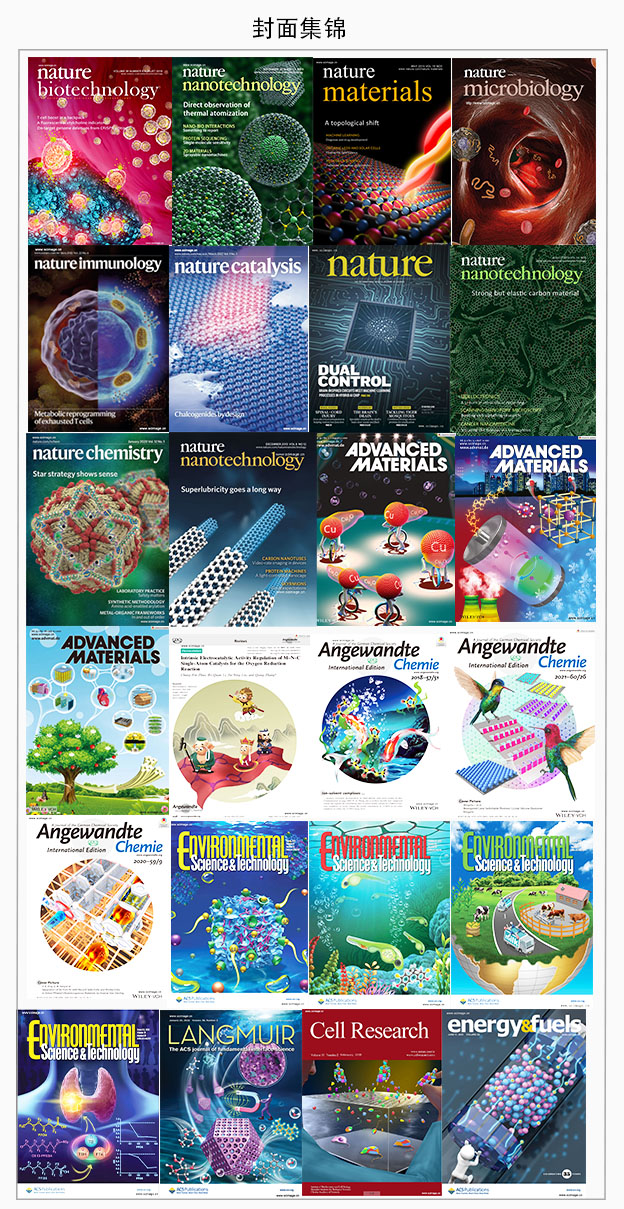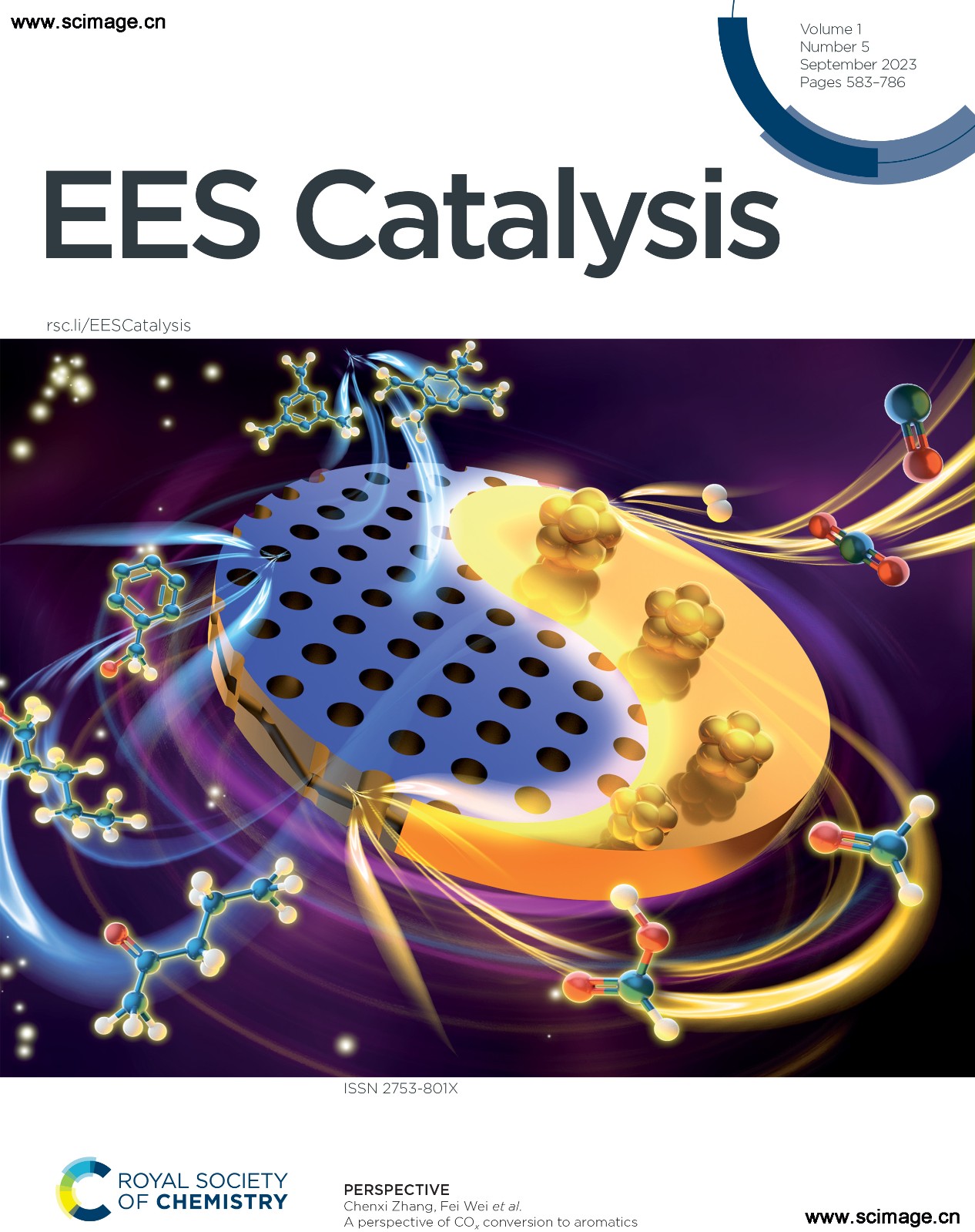博文
2023年9月嘲风作品集(二)
||
▲ Vol 11 Issue 33 | 07 September , 2023
Enhanced peroxidase-like activity of MOF nanozymes by co-catalysis for colorimetric detection of cholesterol
Shuishi Li, Ling Liang, Longfei Tian, Jia Wu, Yuhui Zhu, Yuan Qin, Shulin Zhao and Fanggui Ye
Metal–organic frameworks (MOFs) have been widely used as nanozymes with a great development prospect due to their unique advantages. It is known that the current Fe-based or Cu-based MOF, etc., exhibits the catalytic activity of nanozymes through the Fenton catalytic reaction. And the conversion efficiency of the Fe3+/Fe2+ or Cu2+/Cu+ cycle is key to the catalytic activity. Therefore, we proposed a novel co-catalytic method to promote the reaction rate of the rate-limiting step of Cu2+/Cu+ conversion in the Fenton reaction of Cu2+/H2O2 to enhance the catalytic activity of the nanozymes. As a proof of concept, the MoCu-2MI nanozyme with high catalytic activity was successfully synthesized using Mo-doped Cu-2MI (2-methylimidazole). By using 3,3′,5,5′-tetramethylbenzidine (TMB) as the chromogenic substrate, MoCu-2MI exhibited higher peroxidase-like activity than pure Cu-2MI. Then, it was confirmed that the newly introduced Mo played a crucial co-catalytic role by characterizing the possible catalytic mechanism. Specifically, Mo acted as a co-catalyst to accelerate the electron transfer in the system, and then promote the Cu2+/Cu+ cycle in the Cu-Fenton reaction, which was conducive to accelerating the production of a large number of reactive oxygen species (ROS) from H2O2, and finally improve the activity. Ultimately, a biosensor platform combined with MoCu-2MI and cholesterol oxidase realized the one-step colorimetric detection of cholesterol in the range of 2–140 μM with the detection limit as low as 1.2 μM. This study provides a new strategy for regulating the activity of MOF nanozymes.
https://pubs.rsc.org/en/content/articlelanding/2023/tb/d3tb00958k
▲ Vol 15 Issue 33 | 07 September , 2023
A Ce-MOF@polydopamine composite nanozyme as an efficient scavenger for reactive oxygen species and iron in thalassemia disease therapy
Yijun Yu, Sheng Zhao, Deao Gu, Bijun Zhu, Hanxiao Liu, Wenlei Wu, Jiangjiexing Wu, Hui Wei and Leiying Miao
Periodontitis, an inflammatory disease of oxidative stress, occurs due to excess reactive oxygen species (ROS) contributing to cell and tissue damage which in turn leads to alveolar bone resorption as well as the destruction of other periodontal support tissues. With significant recent advances in nanomaterials, we considered a unique type of nanomaterials possessing enzyme-like characteristics (called nanozymes) for potential future clinical applications, especially in light of the increasing number of studies evaluating nanozymes in the setting of inflammatory diseases. Here, we introduced a therapeutic approach for the management of periodontitis utilizing an injection of cerium oxide nanoparticles (CeO2 NPs) in situ. In this study, our synthesized CeO2 NPs could act as ROS scavengers in the inflammatory microenvironment with ideal outcomes. In vitro and in vivo experiments provide strong evidence on the roles of CeO2 NPs in scavenging multiple ROS and suppressing ROS-induced inflammation reactions stimulated by lipopolysaccharides. Moreover, CeO2 NPs could inhibit the MAPK–NFκB signalling pathway to suppress inflammatory factors. In addition, the results from a rat periodontitis model demonstrate that CeO2 NPs could exhibit a remarkable capacity to attenuate alveolar bone resorption, decrease the osteoclast activity and inflammation, and consequently improve the restoration of destroyed tissues. Collectively, our present study underscores the potential of CeO2 NPs for application in the treatment of periodontitis, and provides valuable insights into the application of nanozymes in inflammatory diseases.
https://pubs.rsc.org/en/content/articlelanding/2023/nr/d3nr01971c
▲ Vol 01 Issue 05 | 07 September , 2023
A perspective of COx conversion to aromatics
Guo Tian, Xiaoyu Liang, Hao Xiong, Chenxi Zhang and Fei Wei
The sustainable production of chemicals through COx hydrogenation is a growing area of interest, with thermal catalytic conversion showing the most promise. Selective hydrogenation to high carbon number products (C8+) remains a challenge, and this perspective focuses on recent advancements in heterogeneous catalytic COx hydrogenation to aromatics. Efficient conversion has been achieved using tandem catalysts composed of metal oxides and nano-porous zeolites, particularly H-ZSM-5, which activate COx and dissociate H2 while promoting precise C–C coupling and cyclization. Such behavior facilitated the system towards a simple biological system. However, understanding the reaction mechanisms, including product selectivity and catalyst activity regulation is still a challenge. This perspective reviews recent progress and integrates quantitative activity descriptors for metal-dependent speciation within the biological metabolic system. H* adsorption energy in the presence of C1 oxygenate intermediates is identified as a speciation-sensitive activity descriptor, while zeolite topologies serve as product selectivity descriptors. These findings establish robust structure–performance relationships and guide the rational design of high-performance COx hydrogenation to aromatic catalysts.
https://pubs.rsc.org/de-ch/content/articlelanding/2023/ey/d3ey00102d
▲ Vol 95 Issue 36 | 12 September , 2023
Amplification-Free Nucleic Acid Testing with a Fluorescence One-Step-Branched DNA-Based Lateral Flow Assay (FOB-LFA)
Kai Sun, Xueqi Wang, Yuxin Qu, Han Wang, and Jing Cheng
The emergence of the global pandemic and the discovery of nucleic acid biomarkers in cancer diagnosis have fostered the development of more accurate and adaptive molecular diagnosis technologies. Current nucleic acid testing (NAT) methods either lack sensitivity or require tedious amplification operations, which could not meet the need for point-of-care (POC) NAT for on-site and community-based diagnosis. Here, we present a fluorescence one-step-bDNA-based lateral flow assay (FOB-LFA) method for amplification-free NAT to realize point-of-care pathogen detection and disease diagnosis. Take COVID-19 as an example, the developed FOB-LFA demonstrated a high sensitivity of 300 copies/mL for the RNA of the SARS-CoV-2 pseudovirus and exhibited high specificity among various homologous pseudoviruses. Further, the result of oropharyngeal swab sample detection suggested the great potential of FOB-LFA in clinical examination. The outstanding performance of FOB-LFA, including high sensitivity, high specificity, low cost, excellent portability, and minimized risk of nucleic acid leakage and contamination, can meet the POC testing demand for the diagnosis of various infectious and genetic diseases.
https://pubs.acs.org/doi/10.1021/acs.analchem.3c02299
<静远嘲风动漫传媒科技中心>设计制作

购书链接:
☆科学的颜值:学术期刊封面故事及图像设计
https://item.jd.com/12802188.html
☆科技绘图/科研论文图/论文配图设计与创作自学手册:CorelDRAW篇
https://item.jd.com/13504674.html
☆科技绘图/科研论文图/论文配图设计与创作自学手册:Maya+PSP篇
https://item.jd.com/13504686.html
☆科技绘图/科研论文图/论文配图设计与创作自学手册:科研动画篇
https://item.jd.com/13048467.html#crumb-wrap
☆SCI图像语法-科技论文配图设计使用技巧
https://item.jd.com/10073529532924.html?bbtf=1


静远嘲风(MY Scimage) 成立于2007年,嘲风取自中国传统文化中龙生九子,子子不同的传说,嘲风为守护屋脊之瑞兽,喜登高望远;静远取自成语“宁静致远”,登高莫忘初心,远观而不可务远。


学习更多绘图教程关注:


https://blog.sciencenet.cn/blog-519111-1409731.html
上一篇:2023年9月嘲风作品集(一)
下一篇:2023年9月嘲风作品集(三)



